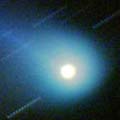
|
The brightness evolution had been slower than a typical comet since its discovery until the perihelion passage in early April. Although it kept bright as 8 mag from mid March to early May, it seems to start fading in mid May as expected, 8.4 mag on May 12 (Michael Mattiazzo). After this, it is not observable in the Northern Hemisphere until late September when it appears very low sky at dawn as 14 mag. It keeps lower than 20 deg high until early July even in the Southern Hemisphere. The comet will fade out rapidly after this, down to 12 mag until early July. Unusually strong non-gravitational parameters are revealed by the orbital calculation, but the reason has not been revealed yet.
Date(TT) R.A. (2000) Decl. Delta r Elong. m1 Best Time(A, h)
May 28 4 15.02 -38 58.5 1.442 1.290 60 9.6 5:27 (306, 17)
June 4 4 47.41 -37 49.4 1.564 1.379 60 9.9 5:30 (305, 16)
|

|
It was fantastic, so bright as 3.5 mag, so large as 30 arcmin, locating high overhead at its best time in early January. Then it has been getting fainter and smaller gradually, and 8.9 mag now (May 15, Carlos Labordena). It looks rather small with a diameter of about 6 arcmin. It is not easy to see with binoculars now, but still easy to see with a telescope. It is visible all night in the Northern Hemisphere, but it becomes very low in the morning. In the Northern Hemisphere, it keeps observable in good condition for a long time while the comet is bright enough visible visually until October when it becomes faint as 14 mag. Dennis Persyk detected the 27-arcmin long anti tail in late May. Now the earth latitude from the comet is small as about 10 degree, which supports to clarify the anti tail. The earth will pass across the orbital plane of the comet in late June, so maybe we can see the long anti tail for a while after this.
Date(TT) R.A. (2000) Decl. Delta r Elong. m1 Best Time(A, h)
May 28 12 40.09 47 24.4 1.823 2.167 95 9.7 20:16 (180, 8)
June 4 12 47.28 44 5.9 1.937 2.244 93 9.9 19:56 (180, 11)
|
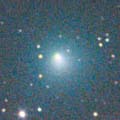
|
It was not visible visually still in February, fainter than 13.9 mag (Feb. 5, Seiichi Yoshida), however, it has been brightening very rapidly as expected after that. Now it is already so bright as 10.2 mag (May 18, Juan Jose Gonzalez). But, this is fainter than originally expected by 0.5 mag. Strongly condensed, and easy to see. It will keep 10 mag until the end of July in calculation. But it may become a naked-eye object due to the Deep Impact mission on July 4. Actually, this is the first experience in our history, and it is very uncertain what will happen on this comet. Observations are strongly encouraged.
Date(TT) R.A. (2000) Decl. Delta r Elong. m1 Best Time(A, h)
May 28 12 54.15 4 33.5 0.746 1.554 123 10.2 20:30 (180, 51)
June 4 12 58.30 2 7.7 0.766 1.539 118 10.1 20:06 (180, 53)
|
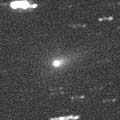
|
It will reach to 10 mag in June and July. It keeps locating rather low in the morning until that. Although it was faint as 15.2 mag on Mar. 14 (Yuji Ohshima), it brightened in April, and finally it became bright enough to be visible visually, 12.3 mag on May 2 (Juan Jose Gonzalez). The comet keeps brightening, and now it is bright as 11.2 mag (May 18, Juan Jose Gonzalez). But, this is fainter than originally expected by 0.5 mag.
Date(TT) R.A. (2000) Decl. Delta r Elong. m1 Best Time(A, h)
May 28 0 37.15 23 24.9 1.477 1.152 51 10.5 5:27 (220, 19)
June 4 1 9.65 23 59.8 1.453 1.114 49 10.3 5:30 (220, 19)
|

|
In January when it was visible in the Northern Hemisphere, it was an 11 mag small object. However, after it has gone to the southern sky, it reached to 8.0 mag, bright enough to be visible with binoculars, from March to April (Mar. 4 and Apr. 7, Alexandre Amorim). It must have started fading after mid April, however, it keeps bright as 8.9 mag still on May 12 (Michael Mattiazzo), brighter than this ephemeris by 1 mag. It had been very low even in the Southern Hemisphere for a while, but it will be higher again after this, and keeps observable while fading gradually. In the Northern Hemisphere, it is not observable until June when it appears in the morning. The ephemeris says it will fade down to 12.5 mag until that time, but it may be brighter than expected. Only one observation was reported since mid April, so it is uncertain how the comet is fading now.
Date(TT) R.A. (2000) Decl. Delta r Elong. m1 Best Time(A, h)
May 28 1 59.58 -6 36.3 1.736 1.234 44 10.5 5:27 (259, 26)
June 4 2 0.61 -3 21.8 1.749 1.315 48 10.9 5:30 (251, 30)
|
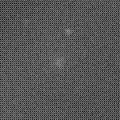
|
It was 18.5 mag in mid January. The brightening was slower than expected. Although it had been unobservable for a while after that, now it is appearing in the morning low sky. It was 14 mag on May 12 (Michael Mattiazzo), and 13.5 mag on May 15 (Ken-ichi Kadota). The comet has been brightening rapidly as expected. In the Northern Hemisphere, it keeps observable for a long time after this, and is expected to reach to 8 mag from July to August. However, it unexpectedly brightened after the perihelion passage in its last appearance, and reached to the maximum brightness about 45 days after the perihelion passage. If it was due to the outburst, it may reach only to 11 mag at best in this return. In the Southern Hemisphere, it only appears in the morning very low sky until early June, but not observable when the comet is brightest.
Date(TT) R.A. (2000) Decl. Delta r Elong. m1 Best Time(A, h)
May 28 1 23.28 27 13.5 1.915 1.317 40 11.1 5:27 (227, 10)
June 4 1 31.13 33 13.8 1.809 1.296 44 10.9 5:30 (219, 9)
|
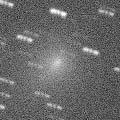
|
New comet. Although it was reported so faint as 18.7 mag at the discovery, Michael Jager observed it on May 24 and found it was unexpectedly bright at around 13-14 mag. It brightened furthermore, 12.7 mag on May 27 (Giovanni Sostero). The diameter is large as 2.8 arcmin. However, it is very diffused, so it will be hard to observe without clear sky despite of the brightness. It wil pass the perihelion on July 5, and it will approach to the sun down to 0.54 AU. It will also come close by the earth. So it is expected to be bright as 12 mag in the evening sky in June. In the Northern Hemisphere, it is observable until late June. In the Southern Hemisphere, it is observable between late June and early July, but locating low in the evening. It will fade out rapidly after July. It will appear at dawn again in August in the Southern Hemisphere, or in September in the Northern Hemisphere, when it will be 14-15 mag at that time. Because the absolute magnitude is faint as 13-14 mag, it can decline at the perihelion passage and become much fainter than expected after that.
Date(TT) R.A. (2000) Decl. Delta r Elong. m1 Best Time(A, h)
May 28 2 9.03 86 4.3 0.804 0.996 65 13.0 5:27 (184,-33)
June 4 8 12.35 74 50.9 0.693 0.882 58 12.3 18:25 (168,-23)
|

|
Although it was only 19 mag in January, it has been brightening rapidly as expected since that, and it reached to 14-14.5 mag in mid May. It seems a bit fainter than this ephemeris. But it must be getting visible visually at 13.5 mag now. It is expected to keep visible as bright as 12-13 mag for a long time until September. In the previous return, it was 1.5 mag brighter than this ephemeris visually. So it can be around 11.0 mag visually at best in this return, too. The condition is good in the Southern Hemisphere. However, it locates very low in the Northern Hemisphere. Especially, it becomes lowest for the northern observers at 15 deg high until the end of June. So it will be easier to see visually in July and August.
Date(TT) R.A. (2000) Decl. Delta r Elong. m1 Best Time(A, h)
May 28 15 52.32 -40 57.9 0.716 1.703 159 12.9 23:27 ( 0, 84)
June 4 15 48.76 -40 34.7 0.694 1.678 157 12.7 22:56 ( 0, 84)
|

|
Not observable. It was bright as 7.5 mag in early January, easy to see with binoculars. However, it faded and got diffused rapidly in the evening sky since that. It faded to 10.7 mag on Mar. 15 visually (Alexandre Amorim), and 11.5 mag on Apr. 4 by CCD observation (Mitsunori Tsumura), then it became too low. Although it became faint very quickly, the fading pace was slower than usual. It will appear in the morning sky again in August. It may be still brighter than 14 mag at that time and visible visually.
Date(TT) R.A. (2000) Decl. Delta r Elong. m1 Best Time(A, h)
May 28 4 10.54 -4 36.0 4.238 3.358 26 12.8 5:27 (277, -2)
June 4 4 14.16 -4 17.2 4.298 3.435 27 12.9 5:30 (273, 4)
|

|
It was 12.7 mag on May 4, visible visually still now (Seiichi Yoshida). It keeps 12.5-13.0 mag since November, however, now it is smaller and a bit fainter than last autmun while going away from the earth. It will be getting lower while fading after this, so it will be invisible visually soon. The altitude will be lower than 10 deg in late June.
Date(TT) R.A. (2000) Decl. Delta r Elong. m1 Best Time(A, h)
May 28 7 38.66 31 7.8 2.482 1.911 45 13.6 18:27 (140, 10)
June 4 7 58.56 30 20.4 2.543 1.930 43 13.8 18:25 (138, 10)
|

|
The condition of this return is bad. It is not observable around the perihelion passage. It will appear at dawn in July at 14.5 mag, then it will be fading after that. It has already appeared in the morning low sky in the Southern Hemisphere. It was 13.6 mag on May 12, as bright as expected (Michael Mattiazzo).
Date(TT) R.A. (2000) Decl. Delta r Elong. m1 Best Time(A, h)
May 28 2 19.65 5 15.3 2.520 1.762 33 13.6 5:27 (252, 15)
June 4 2 35.72 6 20.8 2.525 1.801 35 13.8 5:30 (249, 17)
|

|
Appearing at dawn. No observations in 2005 have been reported yet. It had been always brighter than 13 mag and visible visually all through the season in 2004. In 2005, it is observable in very good condition, almost overhead in the Northern Hemisphere from summer to winter. It can be a good target of observaions if it becomes active as in 2004.
Date(TT) R.A. (2000) Decl. Delta r Elong. m1 Best Time(A, h)
May 28 1 43.87 19 11.0 6.527 5.744 36 13.8 5:27 (236, 12)
June 4 1 48.76 19 44.3 6.462 5.745 41 13.7 5:30 (231, 16)
|

|
It will reach to 9 mag in 2006 spring. In the Southern Hemisphere, it keeps observable until that. In the Northern Hemisphere, it is not observable until 2006 March, except it appears very low in the morning at 12 mag from late August to early September. After 2006 March, northern people can observe it for a long time while it is getting fainter. It had been brightening well as expected until 2005 March. After that, recent brightness is uncertain because it became unobservable in the Northern Hemisphere. It becomes extremely low even in the Southern Hemisphere until June.
Date(TT) R.A. (2000) Decl. Delta r Elong. m1 Best Time(A, h)
May 28 4 38.68 -14 56.9 4.291 3.530 36 14.1 18:27 ( 76, 6)
June 4 4 43.70 -15 19.1 4.209 3.463 37 14.0 5:30 (286, 4)
|
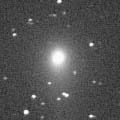
|
Although it had been rather large, well condensed, and easy to see until February, it became diffused in March. However, it keeps bright visually still now, 12.8 mag on May 4 (Seiichi Yoshida). The fading after the perihelion passage is slow, and it will keep visible at 13 mag for a while after this. In the Northern Hemisphere, it keeps the same altitude at 35 deg high in the evening sky until June when it fades down to 14.5 mag.
Date(TT) R.A. (2000) Decl. Delta r Elong. m1 Best Time(A, h)
May 28 7 41.26 67 39.2 3.299 2.854 55 14.2 18:27 (163,-18)
June 4 8 11.45 66 11.7 3.382 2.908 54 14.3 18:25 (162,-17)
|

|
It had been lost for a long time. It was recovered in 1978. However, it was missed in two returns after that, and now it is lost again. Probably it is extremely faint normally, and it was observed only when it rarely brightened. It seems to locate around the predicted position, but it must be much fainter than this ephemeris. The condition in this return is bad. It keeps locating extremely low, so it will be impossible to recover. In the Southern Hemisphere, it locates 20 deg high in the morning from late May to early June. So if the comet unexpectedly brightens again, it may be recovered.
Date(TT) R.A. (2000) Decl. Delta r Elong. m1 Best Time(A, h)
May 28 1 39.63 4 33.0 1.322 0.889 42 14.8 5:27 (246, 23)
June 4 2 16.05 8 56.0 1.344 0.843 38 14.3 5:30 (244, 19)
|

|
It was 16.4 mag at the discovery in March (Mar. 12, R. H. McNaught), but it brightened up to 15.1 mag on May 15 (Akimasa Nakamura). It is expected to be bright as 10 mag in early 2006. In the Southern Hemisphere, it keeps locating high until November while the comet is getting brighter gradually. In the Northern Hemisphere, it keeps locating very low around 15 deg high until September. So, it may be too hard to see visually for a long time.
Date(TT) R.A. (2000) Decl. Delta r Elong. m1 Best Time(A, h)
May 28 20 38.45 -36 58.9 3.044 3.689 122 14.5 4:17 ( 0, 88)
June 4 20 38.79 -37 22.1 2.900 3.621 128 14.3 3:49 ( 0, 88)
|

|
Peculiar asteroid moving along the orbit like a short periodic comet. It passes close by the earth from May to June, and reaches to 14 mag. In the Northern Hemisphere, it is not observable in May. But it moves northwards rapidly, and becomes observable after the beginning of June. However, it fades out very rapidly. It fades down to 15.5 mag in mid June when it becomes high, and 17 mag at the end of June. So it is only the chance to observe it in early June. On the other hand, it keeps locating high from May to June in the Southern Hemisphere. If this object is a comet actually, it may become much brighter than this ephemeris. But it was so faint as 18.5 mag in early April when it passed the perihelion, which suggests this object is indeed an asteroid. It is getting brighter rapidly now, already 15.5 mag on May 22.
Date(TT) R.A. (2000) Decl. Delta r Elong. m1 Best Time(A, h)
May 28 16 32.37 -51 51.8 0.315 1.295 149 14.7 0:13 ( 0, 72)
June 4 16 5.31 -30 48.2 0.335 1.343 167 14.4 23:11 (180, 84)
|
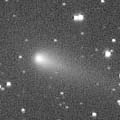
|
Although it had been strongly condensed until early January, it became diffused since late January. It is fading gradually, around 11.5 mag in January and around 12.5 mag in February. It was still bright at 12.6 mag on Mar. 8 (Seiichi Yoshida). Although the brightness evolution before the perihelion passage was extremely rapid, the fading after the perihelion passage is slow as expected. However, it is already very low in the evening. It will be unobservable soon.
Date(TT) R.A. (2000) Decl. Delta r Elong. m1 Best Time(A, h)
May 28 6 57.87 17 52.7 3.336 2.604 37 14.6 18:27 (124, 14)
June 4 7 10.64 17 35.7 3.418 2.636 33 14.7 18:25 (121, 12)
|
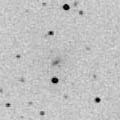
|
New periodic comet with a very short period of 4.4 years. Because it will pass very close by the earth down to 0.1 AU in June, it brightens rapidly. It will reach to 12-13 mag in the evening sky in mid June. However, it will be unobservable soon, too close to the Sun, in late June. It will appear in the morning again in late July at 15 mag, then it keeps observable while fading gradually. If the brightness of this comet would behave like an asteroid, it may reach only to 16 mag at best in June, and may be fainter than 19 mag after July. But actually, it is brightening rapidly, 15.1 mag on May 26 (Yusuke Ezaki).
Date(TT) R.A. (2000) Decl. Delta r Elong. m1 Best Time(A, h)
May 28 14 26.50 2 42.0 0.252 1.225 143 15.4 22:00 (180, 52)
June 4 13 58.53 5 14.7 0.204 1.156 130 14.7 21:04 (180, 50)
|
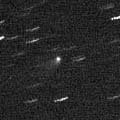
|
It was faint as 16.5 mag in early February. Then it has been brightening as expected, and reached to 15.2 mag in late April (Apr. 27, Ken-ichi Kadota). It will be observable in good condition at 14.5-15 mag until mid July. Because it locates high, it will be visible visually with a large telescope when the sky is clear. It was observed visually at 15.0 mag on May 7 (Shigeki Murakami).
Date(TT) R.A. (2000) Decl. Delta r Elong. m1 Best Time(A, h)
May 28 15 59.12 16 27.9 2.564 3.418 141 14.9 23:32 (180, 38)
June 4 15 40.17 17 4.2 2.597 3.412 137 14.9 22:46 (180, 38)
|

|
New bright periodic comet discovered in 2004 spring. It had been bright at 15.0-15.5 mag from spring to summer in 2004. The ephemeris says it keeps brighter than 19 mag even around the aphelion, however, the comet had not been discovered before 2004. This suggested the comet became bright temporarily last year. But actually, it keeps the same brightness in 2005, too. Now it is 14.8 mag (May 15, Akimasa Nakamura). It will be bright at 14.5 mag until autumn. However, it locates very low, around 20 deg high, in the Northern Hemisphere. So it will be hard to see it visually.
Date(TT) R.A. (2000) Decl. Delta r Elong. m1 Best Time(A, h)
May 28 20 31.61 -28 59.9 2.289 2.967 123 15.0 4:10 (180, 84)
June 4 20 32.53 -29 46.6 2.226 2.977 129 15.0 3:43 (180, 85)
|
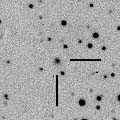
|
It brightened from 18 to 15 mag during one year from the end of 2003 to early 2005. The brightness evolution was much faster than that of a typical comet. After that, it kept 15-15.5 mag until May. It will become too low in the evening at 15 mag in June. Then it can be 13 mag and may be visible visually in next winter.
Date(TT) R.A. (2000) Decl. Delta r Elong. m1 Best Time(A, h)
May 28 6 31.92 45 58.2 6.495 5.712 36 15.0 18:27 (140,-10)
June 4 6 40.39 45 52.7 6.518 5.690 32 15.0 18:25 (138,-12)
|

|
It brightened rapidly from 19 to 17 mag in early 2004. But it is in normal state now, brightening gradually. It was 15.7 mag on Apr. 9. It keeps 15-16 mag for a long time until early 2007. Although it does not locate very high in the Northern Hemisphere, it is also visible visually at 14.3 mag (May 7, Juan Jose Gonzalez).
Date(TT) R.A. (2000) Decl. Delta r Elong. m1 Best Time(A, h)
May 28 15 39.01 -19 46.3 2.197 3.200 170 15.1 23:14 (180, 75)
June 4 15 34.01 -19 47.0 2.208 3.190 162 15.1 22:41 (180, 75)
|

|
It reached to 13 mag and was observed visually in good condition in 2004 autumn. Then it has been fading on and on while being apart from the earth. It will be low in the evening sky at 16.5 mag in August. It will be observable again in 2006, at 16.5 mag from March to April, then it will go away. Next return is in 2018, when it will be 14.3 mag at best.
Date(TT) R.A. (2000) Decl. Delta r Elong. m1 Best Time(A, h)
May 28 8 10.61 53 19.9 2.756 2.309 53 15.8 18:27 (157, -5)
June 4 8 32.59 51 22.9 2.833 2.344 51 15.9 18:25 (156, -3)
|

|
Recovery of a peculiar asteroid 2004 FS101 discovered in 2004 spring. Although it was 18 mag in mid January, it brightened to 16-16.5 mag in mid May. The brightness evolution was rather faster than that of a typical comet. It will be 14.5 mag around 2006 January, although it will be rather low for the northern observers. It keeps observable at 15-16 mag for a long time from 2005 spring to the end of 2006. Because it moves in the northern sky, it keeps observable for a long time in the Northern Hemisphere.
Date(TT) R.A. (2000) Decl. Delta r Elong. m1 Best Time(A, h)
May 28 13 26.35 49 35.2 3.808 4.095 99 16.2 21:01 (180, 5)
June 4 13 20.88 49 52.6 3.850 4.056 94 16.1 20:28 (180, 5)
|

|
Peculiar comet which becomes brightest about 5 months after the perihelion passage. It became brightest in February, about 5 months after the perihelion passage, as expected. However, it was fainter than expected in this return, and reached only to 15.5 mag at best. It was not visible visually, fainter than 14.0 mag (Feb. 5, Seiichi Yoshida). It is fading now, already faded down to 16.7 mag on May 3 (Ken-ichi Kadota).
Date(TT) R.A. (2000) Decl. Delta r Elong. m1 Best Time(A, h)
May 28 10 30.27 27 31.7 3.047 3.083 82 16.8 18:27 (175, 27)
June 4 10 36.89 26 32.4 3.154 3.103 77 16.9 18:25 (170, 28)
|

|
It will be 16.5 mag both in 2005 summer and 2006 summer. It moves southwards, so the condition in the Northern Hemisphere is better in 2005.
Date(TT) R.A. (2000) Decl. Delta r Elong. m1 Best Time(A, h)
May 28 17 36.90 64 51.8 3.854 4.026 92 17.0 1:16 (180,-10)
June 4 17 25.73 64 17.5 3.820 4.003 92 16.9 0:37 (180, -9)
|

|
New periodic comet. Now it is brightest, but only 17 mag. It will be fading slowly after this. It will be low in the evening sky in July.
Date(TT) R.A. (2000) Decl. Delta r Elong. m1 Best Time(A, h)
May 28 13 38.11 -12 0.4 2.037 2.891 140 17.2 21:13 (180, 67)
June 4 13 37.54 -11 54.4 2.087 2.881 133 17.2 20:45 (180, 67)
|

|
Because it is a far object, it has been observed at 17.5 mag for one and a half year since 2003 summer. It has already passed the perihelion, so it will become a bit fainter this year. But it keeps 18 mag until summer.
Date(TT) R.A. (2000) Decl. Delta r Elong. m1 Best Time(A, h)
May 28 15 18.94 44 30.5 6.969 7.418 112 17.9 22:53 (180, 11)
June 4 15 11.34 44 12.4 7.030 7.435 109 17.9 22:18 (180, 11)
|
|
![]()
 C/2004 Q1 ( Tucker )
C/2004 Q1 ( Tucker ) 72P/Denning-Fujikawa
72P/Denning-Fujikawa C/2005 E2 ( McNaught )
C/2005 E2 ( McNaught ) 2004 YZ23
2004 YZ23 78P/Gehrels 2
78P/Gehrels 2 P/2005 JQ5 ( Catalina )
P/2005 JQ5 ( Catalina ) C/2004 K1 ( Catalina )
C/2004 K1 ( Catalina ) P/2004 F3 ( NEAT )
P/2004 F3 ( NEAT ) C/2003 WT42 ( LINEAR )
C/2003 WT42 ( LINEAR ) 117P/Helin-Roman-Alu 1
117P/Helin-Roman-Alu 1 (944) Hidalgo
(944) Hidalgo C/2005 B1 ( Christensen )
C/2005 B1 ( Christensen ) 121P/Shoemaker-Holt 2
121P/Shoemaker-Holt 2 C/2005 K1 ( Skiff )
C/2005 K1 ( Skiff ) P/2005 GF8 ( LONEOS )
P/2005 GF8 ( LONEOS ) C/2003 O1 ( LINEAR )
C/2003 O1 ( LINEAR )![]()




















